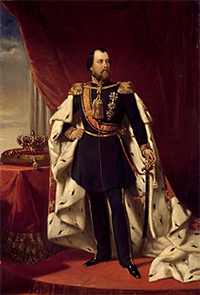King William III of the Netherlands
William III was King of the Netherlands, ruling for more than four decades in the 19th Century. 
He was born on Feb. 19, 1817, in the Palace of the Nation in Brussels. His father was the heir to the throne, King William II, and his mother was Anna Pavlovna of Prussia. When young William was born, his grandfather was William I of the United Kingdom of the Netherlands. Young William grew up at court and at an early age focused on the military. He gained the title of honorary colonel in the army when he was 10. He served in the Grenadiers Regiment when he was in his early teens and then made honorary commander in the Russian army in 1834. He also had a fond taste for a strong, powerful monarchy, identifying with his grandfather much more than with his father. Young William would no doubt have sympathized with William I when that king abdicated, in 1840, rather than accept a more representative government. Young William further frowned on the types of constitutional changes sanctioned by his father when he assumed the throne and then survived by the Revolutions of 1848. Nonetheless, young William accepted the kingship when it was his to take, on the death of his father, on March 17, 1849. The new king was in London when his father died. He returned and assumed the throne. He had married Sophie of ürttemberg a decade earlier. William III made several attempts to assert more authority. He fired several of his high-level ministers and dismissed the States-General more than once. He also stirred up trouble elsewhere. William I had also been Grand Duke of Luxembourg. His son and then his son also had that title, serving as head of state of the tiny entity. In 1856, William III, who wanted to rule more as a monarch of old and not one constrained by a parliamentary democracy, instituted a new constitution in Luxembourg that gave him more authority. His advisors and legislative leaders thwarted similar attempts in his native Netherlands. William and Sophie had by this time had a son, also named William. When the younger William turned 18, in 1858, the king considered abdicating. He decided against it, however, and continued to rule. As the years progressed, he became increasingly known for his erratic behavior, to his family and to his advisers. He and his wife did not see eye-to-eye on most things, and this likely contributed to his nature. He also was physical abusive to his servants and to animals. Queen Sophie died in 1877, and the king looked to marry again. After several episodes of rejected invitations, he found a willing new bride in Emma of Waldeck and Pyrmont; the couple were married in 1879. The king's second marriage turned out to be a happy one in terms of infighting within his family and with his government. However, he suffered increasingly from mental illness. He survived a serious physical illness in 1887 but then proved unfit for rule the following year. His wife and his advisers served in a regency capacity for several months before William died, on Nov. 23, 1890, in Het Loo Palace, in Apeldoorn. William and Sophie had had four children: William (1840), Maurits (1843), Alexander (1851), and Wilhelmina (1880). By the time that the king died, only his daughter was still living. She became Queen Wilhelmina. |
|
Social Studies for Kids
copyright 2002–2025
David White




